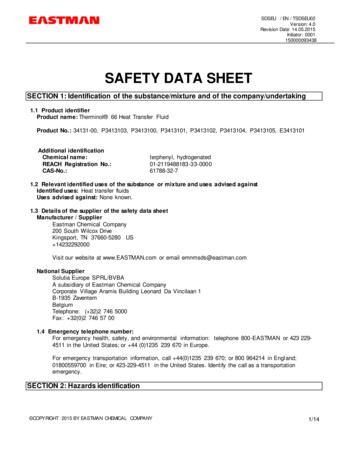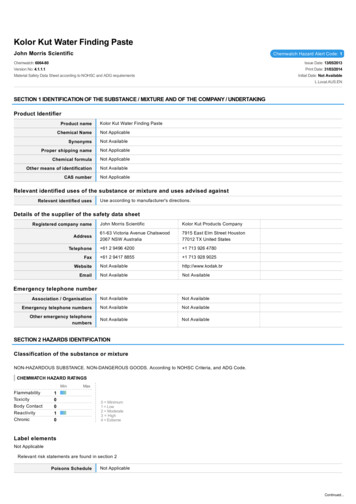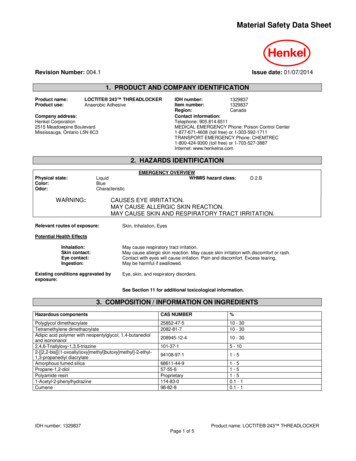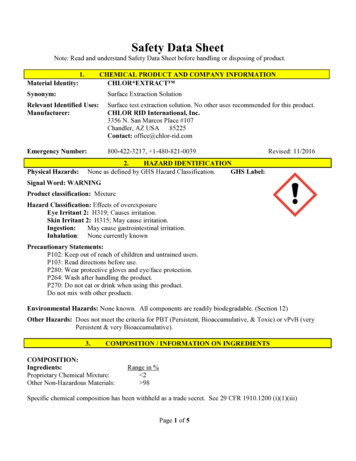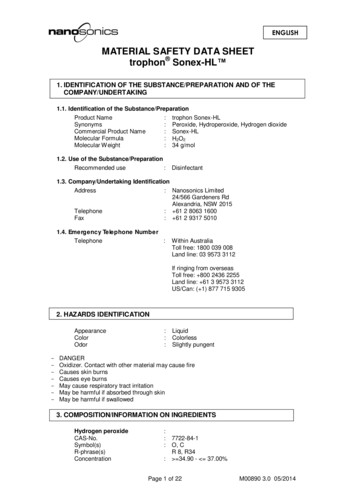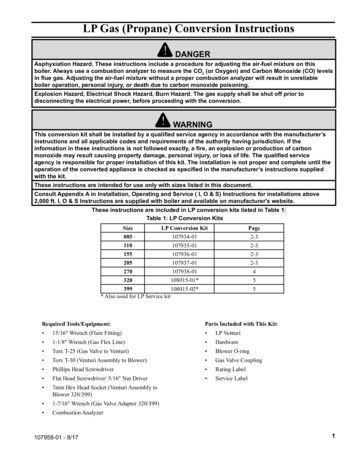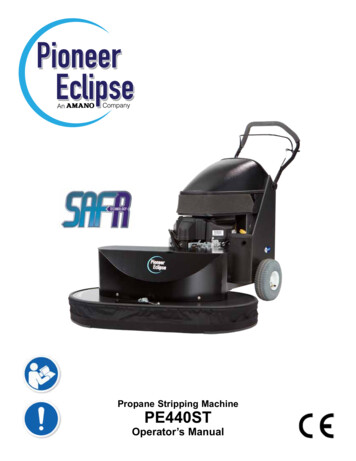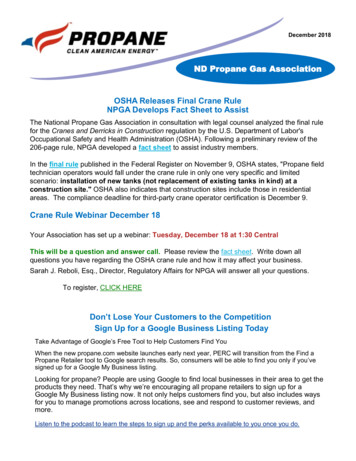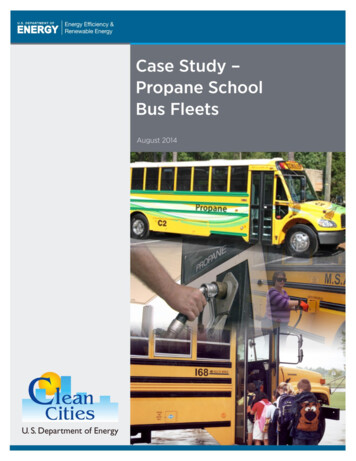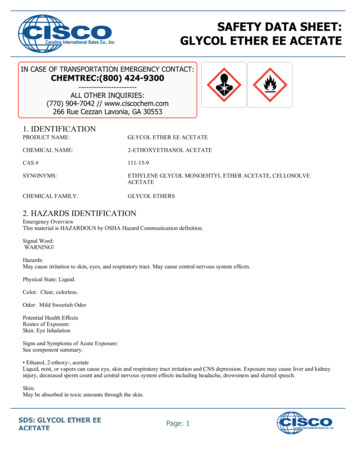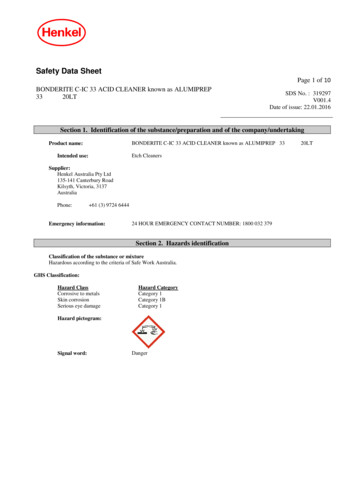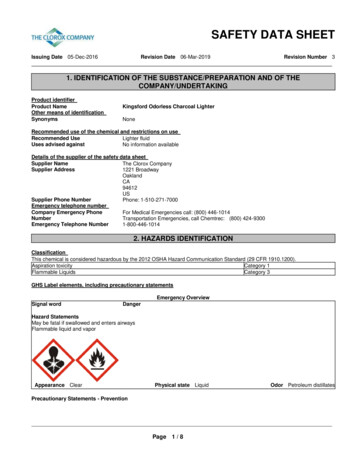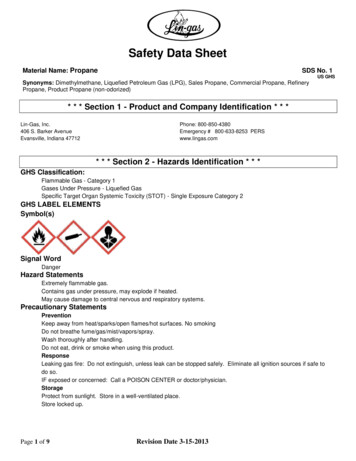
Transcription
Safety Data SheetMaterial Name: PropaneSDS No. 1US GHSSynonyms: Dimethylmethane, Liquefied Petroleum Gas (LPG), Sales Propane, Commercial Propane, RefineryPropane, Product Propane (non-odorized)* * * Section 1 - Product and Company Identification * * *Lin-Gas, Inc.406 S. Barker AvenueEvansville, Indiana 47712Phone: 800-850-4380Emergency # 800-633-8253 PERSwww.lingas.com* * * Section 2 - Hazards Identification * * *GHS Classification:Flammable Gas - Category 1Gases Under Pressure - Liquefied GasSpecific Target Organ Systemic Toxicity (STOT) - Single Exposure Category 2GHS LABEL ELEMENTSSymbol(s)Signal WordDangerHazard StatementsExtremely flammable gas.Contains gas under pressure, may explode if heated.May cause damage to central nervous and respiratory systems.Precautionary StatementsPreventionKeep away from heat/sparks/open flames/hot surfaces. No smokingDo not breathe fume/gas/mist/vapors/spray.Wash thoroughly after handling.Do not eat, drink or smoke when using this product.ResponseLeaking gas fire: Do not extinguish, unless leak can be stopped safely. Eliminate all ignition sources if safe todo so.IF exposed or concerned: Call a POISON CENTER or doctor/physician.StorageProtect from sunlight. Store in a well-ventilated place.Store locked up.Page 1 of 9Revision Date 3-15-2013
Safety Data SheetMaterial Name: PropaneDisposalDispose of contents/container in accordance with local/regional/national/international regulations.* * * Section 3 - Composition / Information on Ingredients * * *CAS #74-98-6Not Available74-84-0115-07-1ComponentPropaneMixed hydrocarbons [butane (C4) and higher]EthanePropylenePercent 85 10 10 10Aliphatic hydrocarbons separated from natural gas having carbon numbers in the range of C2 through C4,predominantly C3 (propane and propylene). Propane offer for commercial distribution will be odorized with traceamounts of odorant (typically well below 0.1% ethyl mercaptan).* * * Section 4 - First Aid Measures * * *First Aid: EyesIn case of contact with eyes, hold eyelids open to allow liquid to evaporate. Cover eyes to protect from light. Seekimmediate medical attention or call 911.First Aid: SkinRemove contaminated clothing. Do not remove clothing that is adhering to the skin. Do not rub frostbit skin. Incase of blistering, frostbite or freeze burns seek immediate medical attention or call 911.First Aid: IngestionRisk of ingestion is extremely low. However, if oral exposure occurs, seek immediate medical assistance or call911.First Aid: InhalationEnsuring rescuer’s personal safety, then remove person to fresh air. If person is not breathing, provide artificialrespiration. If necessary, provideadditional oxygen once breathing is restored if trained to do so. Seek medical attention immediately.* * * Section 5 - Fire Fighting Measures * * *General Fire HazardsSee Section 9 for Flammability Properties.Liquid releases flammable vapors at well below ambient temperatures and readily forms a flammable mixture withair. Dangerous fire and explosion hazard when exposed to heat, sparks or flame. Vapors are heavier than air andmay travel long distances to a point of ignition and flash back.Hazardous Combustion ProductsCarbon monoxide, carbon dioxide and non-combusted hydrocarbons (smoke).Extinguishing MediaUse extinguishing media suitable for the surrounding material, preferably or, any extinguisher suitable for Class Bfires, dry chemical, firefighting foam, CO2, and other gaseous agents. However, fire should not be extinguishedunless flow of gas can be immediately stopped.Container Containment MediaUse water to keep storage container cool. Container has explosion (BLEVE) hazard when exposed to heat andflame. Do not extinguish flame.Page 2 of 9Revision Date 3-15-2013
Safety Data SheetMaterial Name: PropaneUnsuitable Extinguishing MediaNoneFire Fighting Equipment/InstructionsGas fires should not be extinguished unless flow of gas can be immediately stopped. Shut off gas source andallow gas to burn out. If spill or leak has not ignited, determine if water spray may assist in dispersing gas orvapor to protect personnel attempting to stop leak. Use water to cool equipment, surfaces and containersexposed to fire and excessive heat. For large fire the use of unmanned hose holders or monitor nozzles may beadvantageous to further minimize personnel exposure. Isolate area, particularly around ends of storage vessels.Let vessel, tank car or container burn unless leak can be stopped. Withdraw immediately in the event of a risingsound from a venting safety device. Large fires typically require specially trained personnel and equipment toisolate and extinguish the fire. Consider early evacuation in area of 1 mile in all directions from tank. Considerearly activation at additional fire department resources to supplement high water demand.Firefighting activities that may result in potential exposure to high heat, smoke or toxic by-products of combustionshould require NIOSH- approved pressure-demand self-contained breathing apparatus with full face piece andfull protective clothing.* * * Section 6 - Accidental Release Measures * * *Recovery and NeutralizationStop the source of the release, if safe to do so.Materials and Methods for Clean-UpDo not flush down sewer or drainage systems. Do not touch spilled liquid (frostbite/freeze burn hazard!). Considerthe use of water spray to disperse vapors. Isolate the area until gas has dispersed. Ventilate and gas test areabefore entering.Emergency MeasuresEvacuate nonessential personnel and secure all ignition sources. No road flares, smoking or flames in hazardarea. Consider wind direction, stay upwind and uphill, if possible. Evaluate the direction of product travel. Vaporcloud may be white, but color will dissipate as cloud disperses - fire and explosion hazard is still present!Personal Precautions and Protective EquipmentDo not touch spilled liquid (frostbite/freeze burn hazard!).Environmental PrecautionsDo not flush down sewer or drainage systems.Prevention of Secondary HazardsNone* * * Section 7 - Handling and Storage * * *Handling ProceduresKeep away from flame, sparks and excessive temperatures. Bond and ground containers. Use only in wellventilated areas.Storage ProceduresStore only in approved containers. Bond and ground containers. Keep away from flame, sparks, excessivetemperatures and open flame. Keep containers closed and clearly labeled. Empty product containers or vesselsmay contain explosive vapors. Do not pressurize, cut, heat, weld or expose such containers to sources of ignition.Consult NFPA 58 and your local fire inspector for storage regulations.Page 3 of 9Revision Date 3-15-2013
Safety Data SheetMaterial Name: PropaneIncompatibilitiesKeep away from strong oxidizers, ignition sources and heat. Explosion hazard when exposed to chlorine dioxide.Heating barium peroxide with propane causes violent exothermic reaction. Heated chlorine-propane mixtures areexplosive under some conditions.* * * Section 8 - Exposure Controls / Personal Protection * * *Component Exposure LimitsPropane (74-98-6)ACGIH: 1000 ppm TWA (listed under Aliphatic hydrocarbon gases: Alkane C1-4)OSHA: 1000 ppm TWA; 1800 mg/m3 TWANIOSH: 1000 ppm TWA; 1800 mg/m3 TWAEthane (74-84-0)ACGIH: 1000 ppm TWA (listed under Aliphatic hydrocarbon gases: Alkane C1-4)Propylene (115-07-1)ACGIH: 500 ppm TW AEngineering MeasuresUse adequate ventilation to keep gas and vapor concentrations of this product below occupational exposure andflammability limits, particularly in confined spaces. Use explosion-proof equipment and lighting inclassified/controlled areas.Personal Protective Equipment: RespiratoryUse a NIOSH approved positive-pressure, supplied air respirator with escape bottle or self-contained breathingapparatus (SCBA) for gas concentrations above occupational exposure limits, for potential for uncontrolledrelease, if exposure levels are not known, or in an oxygen-deficient atmosphere. CAUTION: Flammability limits(i.e., explosion hazard) should be considered when assessing the need to expose personnel to concentrationsrequiring respiratory protection.Personal Protective Equipment: HandsUse cold-impervious, insulating properly fitting gloves that can be easily removed where contact with liquid mayoccur.Personal Protective Equipment: EyesWhere there is a possibility of liquid contact, wear splash-proof safety goggles and face shield.Personal Protective Equipment: Skin and BodyWhere contact with liquid may occur, wear apron and face shield.* * * Section 9 - Physical & Chemical Properties * * *Appearance:Physical State:Vapor Pressure:Boiling Point:Solubility (H2O):Evaporation Rate:Octanol/H2O Coeff.:Flash Point Method:Lower Flammability Limit(LFL):Auto Ignition:Page 4 of 9ColorlessGas109.73 psig @ 70 F (21.1 C) 43.8 F (-42.1 C)slight (62.4 ppm) @ 77 F (25 C)NDNDPMCC2.1Odor: pH:VaporDensity:Melting Point:Specific Gravity:OdorlessND1.56 @ 32 F (0 C)ND0.531 @ 32 F (0 C)VOC: NDFlash Point: -156 F (-104 C)Upper Flammability Limit 9.5(UFL):Burning Rate: NDChemical Formula:C 3 H8842 F (450 C)Revision Date 3-15-2013
Safety Data SheetMaterial Name: Propane* * * Section 10 - Chemical Stability & Reactivity Information * * *Chemical StabilityThis is a stable material.Hazardous Reaction PotentialWill not occur.Conditions to AvoidKeep away from strong oxidizers, ignition sources and heat.Incompatible ProductsExplosion hazard when exposed to chlorine dioxide. Heating barium peroxide with propane causes violentexothermic reaction. Heated chlorine-propane mixtures are explosive under some conditions.Hazardous Decomposition ProductsCarbon monoxide, carbon dioxide and non-combusted hydrocarbons (smoke).* * * Section 11 - Toxicological Information * * *Acute ToxicityA: General Product InformationPropane exhibits some degree of anesthetic action and is mildly irritating to the mucous membranes. At highconcentrations propane acts as a simple asphyxiant without other significant physiological effects. Highconcentrations may cause death due to oxygen depletion.B: Component Analysis LD50/LC50 Propane (74-98-6)Inhalation LC50 Rat 658 mg/L 4 hEthane (74-84-0)Inhalation LC50 Rat 658 mg/L 4 hPropylene (115-07-1)Inhalation LC50 Rat 658 mg/L 4 hPotential Health Effects: Skin Corrosion Property/StimulativenessVapors are not irritating. Direct contact to skin or mucous membranes with liquefied product or cold vapor maycause freeze burns and frostbite. Contact to mucous membranes with liquefied product may cause frostbite andfreeze burns. Signs of frostbite include a change in the color of the skin to gray or white, possibly followed byblistering. Skin may become inflamed and painful.Potential Health Effects: Eye Critical Damage/ StimulativenessVapors are not irritating. However, contact with liquid or cold vapor may cause frostbite, freeze burns,and permanent eye damage.Potential Health Effects: IngestionIngestion is unlikely. Contact with mucous membranes with liquefied product may cause frostbite and freezeburns.Page 5 of 9Revision Date 3-15-2013
Safety Data SheetMaterial Name: PropanePotential Health Effects: InhalationThis product is considered to be non-toxic by inhalation. Inhalation of high concentrations may cause centralnervous system depression such as dizziness, drowsiness, headache, and similar narcotic symptoms, but nolong-term effects. Numbness, a "chilly" feeling, and vomiting have been reported from accidental exposures tohigh concentrations. This product is a simple asphyxiant. In high concentrations it will displace oxygen from thebreathing atmosphere, particularly in confined spaces. Signs of asphyxiation will be noticed when oxygen isreduced to below 16%, and may occur in several stages. Symptoms may include rapid breathing and pulse rate,headache, dizziness, visual disturbances, mental confusion, incoordination, mood changes, muscular weakness,tremors, cyanosis, narcosis and numbness of the extremities. Unconsciousness leading to central nervoussystem injury and possibly death will occur when the atmospheric oxygen concentration is reduced to about 6%to 8% or less.WARNING: The burning of any hydrocarbon as a fuel in an area without adequate ventilation may result inhazardous levels of combustion products, including carbon monoxide, and inadequate oxygen levels, which maycause unconsciousness, suffocation, and death.Respiratory Organs Sensitization/Skin SensitizationThis product is not reported to have any skin sensitization effects.Generative Cell MutagenicityThis product is not reported to have any mutagenic effects.CarcinogenicityA: General Product InformationThis product is not reported to have any carcinogenic effects.B: Component CarcinogenicityPropylene (115-07-1)ACGIH: A4 - Not Classifiable as a Human CarcinogenIARC: Monograph 60 [1994]; Supplement 7 [1987] (Group 3 (not classifiable))Reproductive ToxicityThis product is not reported to have any reproductive toxicity effects.Specified Target Organ General Toxicity: SingleExposure This product may cause damage to heart.Specified Target Organ General Toxicity: Repeated ExposureThis product is not reported to have any specific target organ repeat effects.Aspiration Respiratory Organs HazardThis product is not reported to have any aspiration hazard effects.* * * Section 12 - Ecological Information * * *EcotoxicityA: General Product InformationLiquid release is only expected to cause localized, non-persistent environmental damage, such as freezing.Biodegradation of this product may occur in soil and water. Volatilization is expected to be the most importantremoval process in soil and water. This product is expected to exist entirely in the vapor phase in ambient air.B: Component Analysis - Ecotoxicity - Aquatic Toxicity Noecotoxicity data are available for this product's components.Page 6 of 9Revision Date 3-15-2013
Safety Data SheetMaterial Name: able.BioaccumulationNo information available.Mobility in SoilNo information available.* * * Section 13 - Disposal Considerations * * *Waste Disposal InstructionsSee Section 7 for Handling Procedures. See Section 8 for Personal Protective Equipment recommendations.Disposal of Contaminated Containers or PackagingDispose of contents/container in accordance with local/regional/national/international regulations.* * * Section 14 - Transportation Information * * *DOT InformationShipping Name: Petroleum Gases, LiquefiedUN #: 1075 Hazard Class: 2.1Placard:* * * Section 15 - Regulatory Information * * *Regulatory InformationComponent AnalysisThis material contains one or more of the following chemicals required to be identified under SARA Section 302(40 CFR 355 Appendix A), SARA Section 313 (40 CFR 372.65) and/or CERCLA (40 CFR 302.4).Propylene (115-07-1)SARA 313: 1.0 % de minimis concentrationSARA Section 311/312 – Hazard ClassesAcute HealthChronic Health---Fire Sudden Release of PressureXXReactive--SARA SECTION 313 - SUPPLIER NOTIFICATIONThis product contains the following toxic chemicals subject to the reporting requirements of section 313 of theEmergency Planning and Community Right-To-Know Act (EPCRA) of 1986 and of 40 CFR 372:INGREDIENT NAME (CAS NUMBER)Propylene (115-07-1)Page 7 of 9CONCENTRATION PERCENT BY VOLUME30 maxRevision Date 3-15-2013
Safety Data SheetMaterial Name: PropaneState RegulationsComponent Analysis - StateThe following components appear on one or more of the following state hazardous substances sYesPAYesYesYesRINoNoNoComponent Analysis - WHMIS IDLNo components are listed in the WHMIS IDL.Additional Regulatory InformationComponent Analysis - InventoryComponentPropaneEthanePropyleneCAS CEINECSEINECSEINECS* * * Section 16 - Other Information * * *NFPA Hazard RatingHMIS Hazard 420ModerateSevereMinimal*ChronicKey/LegendEPA Environmental Protection Agency; TSCA Toxic Substance Control Act; ACGIH American Conference ofGovernmental Industrial Hygienists; IARC International Agency for Research on Cancer; NIOSH NationalInstitute for Occupational Safety and Health; NTP National Toxicology Program; OSHA Occupational Safetyand Health Administration., NJTSR New Jersey Trade Secret Registry.Literature ReferencesNoneOther InformationInformation presented herein has been compiled from sources considered to be dependable, and is accurate andreliable to the best of our knowledge and belief, but is not guaranteed to be so. Since conditions of use arebeyond our control, we make no warranties, expressed or implied, except those that may be contained in ourwritten contract of sale or acknowledgment.Page 8 of 9Revision Date 3-15-2013
Safety Data SheetMaterial Name: PropaneVendor assumes no responsibility for injury to vendee or third persons proximately caused by the material ifreasonable safety procedures are not adhered to as stipulated in the data sheet. Additionally, vendor assumes noresponsibility for injury to vendee or third persons proximately caused by abnormal use of the material, even ifreasonable safety procedures are followed. Furthermore, vendee assumes the risk in their use of the material.End of SheetPage 9 of 9Revision Date 3-15-2013
Page 1 Revision Date 3of 9-15 2013 Safety Data Sheet Material Name: Propane SDS No. 1 US GHS Synonyms: Dimethylmethane, Liquefied Petroleum Gas (LPG), Sales Propane, Commercial Propane, Refinery Propane, Product
